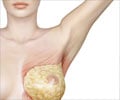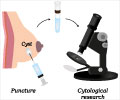New research uncovers key insights into breast cancer progression and drug resistance, paving the way for more effective treatments and personalized therapies.

New Protein Duo Drives Breast Cancer Progression
These proteins, HER2 and αVβ6 integrin, are already known to independently predict cancer outcomes, but have now been found to work together through a newly discovered ‘crosstalk’ mechanism that drives cancer cell invasion. Importantly, this mechanism is disrupted in breast cancer cells resistant to trastuzumab, a common treatment for HER2-positive breast cancer, offering valuable insights into why some breast cancers become harder to treat.‘Higher levels of the GDI2 protein might be a secret weapon against #breast_cancer. Could this lead to new treatment strategies? ’





The research team used advanced proteomic analysis to uncover that when αVβ6 integrin is activated, it recruits HER2 along with a network of molecules known as RAB5, RAB7A and GDI2. This network facilitates direct communication between αVβ6 and HER2, controls how they move within cells and triggers signals that drive cancer. However, in trastuzumab-resistant breast cancer cells, this intricate network breaks down. A key regulator in the network, GDI2, is lost, leading to disruption of the αVβ6-HER2 connection. As a result, the cancer adapts and becomes more invasive through alternative pathways, meaning drugs designed to block αVβ6 or HER2 no longer prevent cancer invasion. This highlights a critical shift in how tumour cells adapt to overcome the effects of targeted therapy.
The study’s findings also link these molecular interactions to patient outcomes. αVβ6 expression predicts an increased likelihood of relapse after trastuzumab treatment. This makes αVβ6 a promising biomarker for identifying patients at higher risk of treatment failure and a potential target for therapies to overcome resistance.
Dr. Mark Morgan, the study’s lead researcher and Senior Lecturer in Molecular & Clinical Cancer Medicine said: “These findings are pivotal to understanding how breast cancer invades tissue, but also how it becomes resistant to targeted treatments. The discovery of this αVβ6-HER2 crosstalk mechanism, and its disruption in resistant cells, opens up new avenues for therapeutic interventions.”
By targeting the RAB5/RAB7A/GDI2 module or restoring its normal function, it may be possible to prevent or delay the onset of resistance in HER2-positive breast cancers. Moreover, monitoring αVβ6 expression in patients could help predict treatment outcomes and guide personalised therapies.
Advertisement
Dr Morgan adds: “The study also found invasion of trastuzumab resistant cells is no-longer stopped by reagents that block αVβ6 function. However, these resistant cells have very high levels αVβ6 on their surface. So, we now want to explore developing new drugs that specifically target cells with high αVβ6 levels and either deliver a lethal warhead, or re-programme them to be targeted by the patient’s own immune system.”
Advertisement















